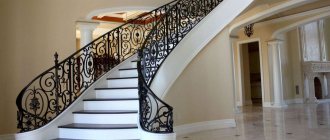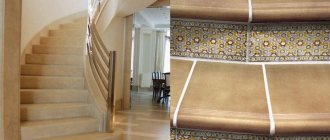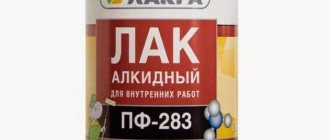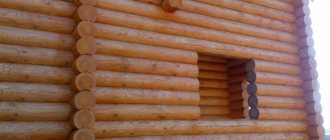Wood is most often used to make stairs in individual houses. The material is quite easy to process and can be given any shape. The surface retains its original properties for a long period. Flights of stairs usually occupy a central place in a building and serve as decoration for the premises. They are the main focus, highlighting, and coloring that can highlight the most effective elements.
Choosing methods for applying paint and varnish coatings, as well as coloring materials, is a rather interesting task. The paint for a wooden staircase is selected by the owner of the building and the performers.
Paint for wooden stairs
The need to paint the stairs
Reasons for painting include:
- Abrasion of an unprotected surface due to prolonged or frequent use;
- Even if you do not use the railings, the microclimate (air humidity, atmospheric parameters) in the room contributes to the exposure of the coating. Cracks may be visible. The material may dry out;
- Unsuitability of steps and frame, wear of elements;
- Beautiful design;
- Design update.
Constantly walking up stairs or using handrails leads to damage and peeling of wood or other material.
Varnish coating
Before varnishing, check on small fragments how a particular varnish behaves. Which shades are the most attractive?
The varnish is applied in cold and hot conditions. Some types penetrate better if they are preheated to a temperature of 50...60 ⁰C (alkyd and alkyd-urethane). Of course, the process becomes more complicated, but the penetrating abilities increase several times.
Some craftsmen do not heat the varnish; they heat the treated surface. You need to avoid overheating here. Do not allow boiling in the surface layer. Using a hair dryer, heating is carried out to a temperature of 60...75 ⁰С.
Varnishing is done with a brush, roller, swab or spray. Everyone may have their own preferences.
Attention! When varnishing, the room is closed from foreign objects and dust.
Most varnishes are harmful to the human body, so you need to follow safety precautions:
- use gloves;
- wear respirators that protect the respiratory system;
- use safety glasses if necessary.
The first stage of drying is carried out with doors and windows closed. Dust particles or insects can ruin the surface of the stairs. Only after drying until sticking stops can the room be opened so that solvent vapors can escape.
Requirements for processing spans
Any dye is slightly diluted. This consistency dries faster and spreads evenly over the coating.
The best effect appears after applying 2-3 layers. The painting tool also plays a big role.
The following requirements apply to the processing of spans:
- Wood in the house needs to be processed to a minimum. For example, it does not need to be primed before applying varnish. It is recommended to use hardwood, sanding the surface and staining it;
- The varnish can be matte (or semi-matte), glossy. Difference in light reflection. Glossy shine is not always appropriate in the house, but dullness emphasizes wood and its texture;
It is better not to take toxic-based materials or reagents with an unpleasant odor.
- It is more convenient to work when paint and varnish materials are purchased ready-made;
- With quick-drying dye, you need to work quickly, otherwise drips and sagging may remain.
Even if such seemingly insignificant moments are taken seriously, the staircase will decorate any room.
The best effect appears after applying 2-3 layers.
Types of paints and varnishes
To give the staircase a finished look, several types of paint and varnish coatings are used. These are varnishes, impregnations and paints themselves. The former emphasize the structure of the wood (tinting) or fix the result (transparent), the latter also emphasize the beauty of the wood pattern, but require additional fixation with a transparent varnish. The paints allow you to paint the stairs as you please.
Coloring is done not only for aesthetic purposes. On the floor, tongue and groove pine boards are most often used. Despite its strength, unopened wood wears out 5 times faster. This is due to the fact that dust and grains of sand become clogged in the pores, which over time destroy the structure of the floorboards. By painting a staircase made of pine or any other wood with varnish or paint yourself, you extend its service life.
stain
Stain is one of the cheapest compositions for covering stairs. Impregnation comes in different colors. It is designed to protect the wood and give it some shade. But it is better not to cover the stairs only with stain - after drying, you should use varnish.
It is customary to use a primer before applying varnish or paint, as it improves adhesion to the wood and makes the wood structure more uniform. If you tint the primer a little, you can emphasize the characteristic wood grain. The primer also contains substances that prevent the wood from rotting.
Clear/tinted wood varnish
Varnish is used to cover steps, balusters and railings. The colorless composition does not hide the wood texture
It is very important that the sanding of all elements of the staircase is carried out at the highest level. Transparent varnishes come in several types:
- Latex. Non-toxic material, safe for humans and animals. When applied to wood, it forms a thin, durable, water-resistant layer. It has antiseptic properties - protects wood from mold and rot. Can be used both indoors and outdoors.
- Water-based or acrylate. It has no unpleasant odor, is non-toxic, forms a fairly durable coating that is resistant to mechanical damage, and prevents the aging of wood.
- On synthetic resins. Such varnishes dry quickly, are resistant to aggressive environments (alkalies, acids), and are used only for interior work. Do not use synthetic resin varnishes to paint steps. They are suitable for balusters and railings.
- Yacht. There are different types, depending on the base - alkyd and its varieties (urethane-alkyd, alkyd-urethane) and acrylate. It is toxic, so when using it inside a living space, wear a respirator, otherwise the probability of poisoning is 99%.
Advice! Use clear yacht varnish to paint stairs only as a last resort. It is poisonous even after drying.
Tinting varnishes include oil-based compositions. With their help you can change the color of wood from pale yellow to rich brown. When choosing, you need to look at what percentage of oil is included in the composition. To paint the steps of the stairs, this parameter must be at least 65%. In this case, you will get a durable, wear-resistant coating. If the oil varnish contains only 50% oil or less, there can be no talk of any strength. This composition is suitable only for balusters and railings.
Wood paints
You can find a great variety of different formulations on sale. But which one is suitable for painting wooden stairs? To answer this question, you need to consider the types of paints used for wood:
Advice! Alkyd paints for wood give consistently good results. Choose them if you want to save a little money and get high-quality staircase coverage.
Paste for covering stairs
Paste is considered an unconventional type of coating. It consists of linseed oil and beeswax. The consistency of the paste depends on the hardness of the wood. If the wood is hard, then there should be four times more linseed oil than wax. For soft breeds, use two parts oil to one part wax. You can make your own pasta or buy it at the store.
Surface treatment is quite simple: the paste is simply rubbed in, for this you need to use a natural lint-free cloth - this will make the surface of the stairs a little matte, with a silky shine.
Requirements for coloring agents
If the staircase is made of expensive wood, then it is better not to paint over it, but to highlight it. The surface is first primed, then painted with paint with a low degree of coverage. To varnish wood, you can use clear or tinted varnish.
If the staircase is located inside the house, then it is more convenient and practical to use quick-drying products without a pungent odor, marked “odorless” or “eco-friendly”. The stairs to the attic are treated with durable paints or solvent-based varnishes.
The steps of the stairs are treated with abrasion-resistant material. Before purchasing any material, it is advisable to read the instructions and application rules.
If the staircase is made of expensive wood, then it is better not to paint over it, but to highlight it.
Varnish for stairs: types and differences
In construction stores, the range of varnishes for wooden stairs is huge. Choosing the right product among this variety can sometimes be very difficult. In order not to get confused in the store and not waste your money, you need to understand in advance the types of varnishes, the advantages and disadvantages of each of them.
Types of varnishes and their main properties:
- Alcohol-based - easy to apply, after drying they are highly resistant to damage. Such products must be applied in several layers. Their main drawback is low water resistance.
- Alkyd - after their application, a hard, transparent film is formed on the surface. Alkyd varnish is not afraid of exposure to water and is ideal for application for both indoor and outdoor stairs.
- Oil paints have low resistance to external factors, so they are best used for interior painting. After drying, such varnishes form a hard layer with a yellowish tint on the surface of the object being painted.
- Acrylic - gives wood a certain color.
- Nitrocellulose - dry quickly, used indoors.
- Polyester - after drying, they form a dense, hard film that needs to be treated with polish. Resistant to water and other influences.
- Polyurethane - have a high cost due to their strength, wear resistance and environmental friendliness.
- Epoxy - resistant to alkali, water and mechanical damage.
- Polyurethane - have a high cost due to their excellent strength, wear resistance and environmental friendliness.
- Oil is an environmentally friendly wax-based product that is easily absorbed, easy to apply, and has no unpleasant odor. Oils also have bactericidal and water-repellent properties, and after drying they are particularly strong and durable.
The durability and quality of painting, as well as the safety of the material, depend on the correctness of the chosen varnish.
Products for painting wooden stairs
How to paint a wooden staircase in a house to the second floor? Options below...
Lucky
“Yacht” varnish is durable and easy to use. In particular, varnish with a matte composition is suitable for any coating, as it perfectly masks scratches and various defects. At the same time, the right varnish will highlight the texture of the rock.
Although oil varnishes weather quickly (they are made from sandarac and shellac), they are not moisture resistant. Many people prefer to use alkyd varnishes (outdoors too). Polyester varnishes are characterized by a shiny film, but polyurethane varnishes have a longer service life.
The right varnish will highlight the texture of the rock.
Paints
Paint not only protects the surface, but also gives the desired shade. Acrylic paint is water-based. It is reliable and easy to apply. Has the property of frost resistance. True, high moisture resistance.
If you want to use oil paint, you must use a respirator. The room must be ventilated, otherwise you can get toxic poisoning. Glossy compounds have increased slip properties. This is also important to consider.
Paint not only protects the surface, but also gives the desired shade.
Enamels
Enamel is similar to paint, but differs in composition. If you paint a wooden staircase with it, it will certainly shine. Special wood enamel is used exclusively inside the house. After application, drying is required for at least 72 hours.
The combination of two types of coatings looks beautiful: varnish and enamel of different shades. There are glyphthalic, oil, nitro enamels and other types of enamel.
Special wood enamel is used exclusively inside the house.
Impregnations
A type of impregnation is stain. It has an antiseptic effect. After treatment with stain, the wooden surface becomes non-flammable. When choosing it, it is worth remembering that the wood underneath darkens and acquires a rich shade. If a beginner is painting, then wax or oil impregnations would be the ideal option. Nitro-impregnations and alcohol impregnations are chosen by professionals in their work.
After treatment with stain, the wooden surface becomes non-flammable.
Material selection rules
In the huge variety of paint and varnish products that manufacturers offer today, there are several materials suitable for painting wooden stairs. These are various varnishes, stains, impregnations and paints that are easy to apply with your own hands using a roller, brush or spray.
Lucky
Varnishes are most often used for processing wooden structures because they do not cover the grain of the wood, which is very important when decorating the interior of rooms. To decide which varnish is best for treating a wooden staircase, let’s look at their main types
Oil products are a mixture of resins (artificial or natural) with vegetable oils. Not the best option because it has low wear resistance, but it is cheap.
Alcohol varnishes are a solution of resins with alcohol. During the application process, the alcohol quickly evaporates, leaving a fairly durable layer of resin on the treated surface. The varnished surface is easy to polish, but has low water resistance. Such compositions can be used for painting balusters.
The production of alkyd varnishes is based on alkyd resins dissolved in white spirit or other organic solvent. They have high wear resistance, increased strength, and are not afraid of changes in temperature and humidity. So they can be safely used when processing street stairs.
Epoxy varnishes are characterized by high mechanical strength, water-repellent properties, and inertness to alkalis. Often two-component formulations are sold that require mixing before application.
Experts believe that polyurethane and polyurethane-acrylate varnishes are best suited for treating wooden stairs. They have all the advantages of the above compounds, but have one drawback - a high price, which is compensated by a long service life.
You can also use yacht varnish to paint outdoor wooden stairs. It is produced on the basis of the same polyurethane or other polymeric substances and includes special additives that provide high strength.
Paints
First of all, it is necessary to note that paints hide the grain of the wood, so they are used only if the task is not to emphasize the texture of the wood. Although there are also glazing compounds that can be used to give only a slight tint to a wooden product.
In terms of variety of colors, they have no equal. But not all brands on the market can be used for painting stairs made of pine, oak or other wood.
Here are those recommended for painting wood:
- acrylic. The resulting coating is durable, waterproof and breathable; walking on it is not slippery. Acrylic compositions are suitable for painting stairs to the second floor inside the house; they can be used to process railings, steps and balusters;
- alkyd. Withstands negative temperatures and forms a flat, smooth surface when painted. They must be applied to well-dried wood;
- oil These paints were once the most common, but have now been replaced by acrylic compositions. They take a long time to dry and form streaks; if not handled carefully, they emit a specific smell when painting;
- enamels. Essentially, it is a mixture of varnish and pigment, so the composition has the characteristics of the varnish that was used in its production.
If the wooden staircase is located indoors, then interior acrylic composition is quite suitable for painting it. For outdoor wooden stairs, it is better to choose more durable finishing materials, such as polyurethane.
Impregnations and stains
Antiseptics and fire retardants are used as impregnations for treating wooden stairs.
The former fight the formation of colonies of harmful microorganisms on the wood surface, the latter are fire-fighting agents. Today, manufacturers offer universal impregnations that have these two properties.
Stain is an antiseptic impregnation that changes the shade of wood. It has no other functions. Usually, after applying the impregnations, the stairs are varnished.
Oils
Wood oils are made from a variety of natural oils and are a modern alternative to varnishes. The oil penetrates deeply into the structure of the wood, protecting it from mechanical stress, the appearance of fungi and mold.
Tips for choosing a coloring agent
To preserve the grain of the wood, you need to use a glossy varnish. For exterior work, solvent-resistant paints are needed. It is advisable to paint the steps with a composition that prevents evaporation. Enamel compounds help protect the wood.
If you have chosen a tinted varnish, then first the base should be painted dark. Any façade paint can be used to process wood. When choosing a shade of paint, you need to remember the style of the house so as not to spoil the wood.
It is advisable to paint the steps with a composition that prevents evaporation.
First stage: selecting the color
If you decide to stick with natural oils, don’t forget that the final color depends not only on the color of the product itself, but also on the type of wood. The final shade of the coating is influenced by the following factors: the color of the tree itself, its density, the presence of resins and juices. This determines how deeply and intensively the oil will penetrate into the thickness of the base, and therefore how easily the pigment will penetrate into the wood. In denser areas and areas where the pores of the wood are closed, the color will be less intense.
To ensure that the result is not unexpected, you need to purchase a sample of the oil and do a test treatment on the tree that you plan to use.
Recommendations for choosing colors
Light shades always look noble. The only thing is that they get more dirty. Dark colors look even darker in the twilight. In general, white marches and a dark floor look beautiful according to the classics. Another option: black, white and lilac with glitter? When painting, the type of wood is an important consideration.
How to paint a staircase in two colors? This can be solved by repainting the risers to match the color of the walls, and the steps to the color of the floors. Or you can change the color after one attack. Lots of options!
Light shades always look noble.
Features of pine wood
Working with pine is somewhat more difficult than working with cedar or oak. Soft wood requires fine sanding and careful selection of finishing agents.
The density of the material depends on the growing conditions of the tree:
- During warm periods, intensively growing fibers form a loose mass. Cold years provide hard and dense wood.
- Pine harvested in the mountains has a dense and uniform texture, while pine grown on sandy soils has a light, loose, fibrous texture.
- Northern pine is of better quality than material mined in southern latitudes.
Because of these qualities, the processing of wooden steps of a pine staircase becomes more difficult, since most of the resulting lumber absorbs the processing agents unevenly. Unsightly stains appear under the transparent coating, which is extremely unpleasant for aesthetic reasons. Resin (resin) contributes to the appearance of color spots on the surface of pine products. If the raw materials are harvested in winter, when the bulk of the resin is pumped by the tree into the root system, the fibers remain drier, cleaner and stronger. They absorb processing agents evenly. Stains and stains appear on wood cut down during the spring-summer sap flow. When brought into a warm, dry room, it begins to push the resin out. This is one of the conditions for choosing what to cover the steps of a pine staircase.
The steps of internal stairs are usually built from edged solid boards. But they often use glued boards, which have greater strength and wear resistance. The difference in the color of the lamellas from which such a board is assembled is especially noticeable. In addition, the lamellas begin to warp over time due to changes in humidity, and gaps form between them. By choosing a matte tint varnish for the steps of a pine staircase, you can hide minor visual defects and unevenness of the wood.
On glued boards the difference in the color of the lamellas is especially noticeable
If you want to leave the interfloor wooden staircase in its original natural color, you will have to use special processing agents: primer, mastic, wax, stain. A simpler option is to apply a decorative opaque coating to the pine staircase. Therefore, the answer to the question of how to paint the steps of a pine staircase is largely determined by the quality of the lumber and the desire to preserve or, on the contrary, cover up the wood pattern.
Treatment of softwood stairs
Before treating a staircase made of pine needles, it is better to remove the resin from it. If this is not done, the coloring composition will not be able to penetrate inside, and the resinous areas will darken. And paint does not adhere well to surfaces impregnated with resin. It’s a good idea to treat stairs with an acetone solution. Excessively tarred areas should be scraped off with a knife, and the recesses should be covered with putty.
Before treating a staircase made of pine needles, it is better to remove the resin from it.
Paint coating
For opaque finishes, pre-priming is used. Acrylic or alkyd primers will be very convenient here. They penetrate quite deeply into the wood and form strong adhesive bonds.
The subsequent paint will lie firmly on the surface.
Painting is done with a roller or brush. The roller makes it possible to quickly and evenly apply an even layer to steps and risers. A brush is convenient for painting balusters and railings.
For high-quality painting, the layer must be applied twice. The second painting is carried out only after the previous layer has completely dried.
What is the best way to paint a pine staircase?
How to paint a pine staircase in a house or country house? The best idea for painting a wooden staircase made of pine is alkyd/enamel paints, polyurethane varnishes. Defects in the pine material are hidden with thinned paint. Although the right one is expensive, it takes a long time. Acrylic paint can also work. It is fragrance-free and the tone can be mixed (this is even more interesting).
The best idea for painting a wooden staircase made of pine is alkyd/enamel paints, polyurethane varnishes.
How to paint
To process pine stairs, the following are used:
- Impregnations with antiseptic and fire retardant properties. They are made on a water, alcohol, acrylic, wax base.
- Stains (stains) for tinting wood. Pigmented impregnations do not form a surface layer, but penetrate into the fibers and make the wood texture expressive. They are made on a water, alcohol, acrylic, oil, wax, and chemical basis.
- Polishes. A transparent coating is applied to the wood, preserving its natural color and pattern, providing a radiant glossy and semi-gloss shine. Can be applied to a layer of paint or varnish to enhance the decorative effect of the coating. It is made on a water, alkyd, oil, wax base.
- Lucky. Transparent material that does not hide the natural appearance of wood. Creates a durable protective layer. It is made on an oil, alcohol, nitrocellulose base. Apply over stain.
- Enamels. They are pigmented varnishes. They form a protective colorless or decorative, glossy or matte hard layer. They have a slight odor and dry quickly.
- Paints. Create a decorative protective layer. Selected by color to match the overall interior design. They are made on an alkyd, oil, acrylic base. They mask minor wood defects and are applied to protective impregnation and previously painted surfaces.
To ensure a high-quality and durable coating, cover the wood only with high-quality materials purchased in specialized stores or from manufacturers.
Which painting material to choose: comparison table
| Types of paints | Advantages | Flaws |
| Oily | Moisture-resistant, rich in color, creates a reliable protective film | They take a long time to dry, do not “breathe”, have a strong toxic odor, lose their shine in areas of wear, are afraid of alkalis, and can peel off over time |
| Enamels | Moisture resistant, form the most durable and smooth surface, dry quickly, lie flat | They provide only a matte surface and are intended for interior use only. |
| Acrylic, acrylate | Water-repellent, breathable, water-soluble, quick-drying, low odor, lays flat | They only provide a matte surface. |
| Alkyd | Moisture-resistant, dry quickly, form a smooth surface with a polishing effect | Contain solvents, have a pungent odor that lingers in the room for some time, a short-lived coating, and may peel off over time |
DIY staircase painting
How to paint a pine staircase with your own hands? It's possible! You just have to take into account some details and follow the step-by-step guide. If it seems that the task is impossible, then you can invite a construction company.
You will have to take into account some details and follow the step-by-step guide.
Preparatory work
If everything is decided, then feel free to get down to business:
- Remove all debris and dirt. Wash the stairs.
- Fill cracks and chips on the surface.
- Smooth out defects with sandpaper.
- Apply primer 2 times or stain 1 time.
- Mix the paint well
- Maintain room humidity.
If everything is decided, then feel free to get down to business.
Painting the stairs
To avoid inequality, a test sample is made on a waste board. How to paint a pine staircase (and not only) with your own hands? Falling out knots must be glued with epoxy glue. The primer is ideal for pine. It is important to sand the openings between layers. The gel stain has proven itself well.
To avoid inequality, a test sample is made on a waste board.
How to properly coat wood with oil
To work you will need 3 brushes. The widest one is more convenient for painting the steps. Fine will be needed for lubricating hard-to-reach places. Use a medium brush to paint the rest of the details.
Unlike varnish or paint, oil is applied in a thin layer, almost rubbed in. Residues that have not been absorbed into the wood should be carefully removed after 15-30 minutes with a rag or rag. The wood is treated with oil twice.
Although it takes at least 6-12 hours for the composition to dry completely, the stairs should be used with extreme caution at first - the coating will finally gain strength only after a couple of weeks. For carpeting, you need to wait even longer - about 3 weeks.
So, painting a wooden staircase with your own hands is not that difficult. The most important thing is to choose the right composition and strictly follow the technology for applying the paint and varnish composition. In order for the staircase to fit stylistically into the overall interior, it is necessary to carefully consider the color shade of the paint and varnish material.
Variations of what color to paint a staircase in a wooden house
Each owner chooses the colors he likes. Preference is given to black and white variations (white oak), brown and cherry. You can do it in an original way: each step is painted in a new color or shade of color. Drawings can be painted on the steps in black, and the steps themselves can be light. Sometimes the amber color of the wood looks beautiful, and sometimes the color of mahogany. Some people like to match the color to the interior color of the room or style.
Each owner chooses the colors he likes.
Self-help errors
There is no need to immediately paint the stairs with expensive paint. To begin with, the coating is treated with an antiseptic or bleach. Railings and railings must be painted with UV-resistant material. Significant rookie mistakes:
- Incorrect application of products;
- Insufficiently prepared surface;
- Ignoring professional advice.
Railings and railings must be painted with UV-resistant material.
Let's sum it up
From the outside it may seem that performing such work does not cause serious difficulties and can be done independently. In reality, selecting the right product for a particular tree and applying it requires some experience and knowledge of how impregnation works.
It must be remembered that a log house does not tolerate mistakes. If something was done initially incorrectly, it is often possible to correct the result only by completely replacing the damaged element. Therefore, it is much easier and cheaper to immediately seek help from specialists. The employees are precisely those people who have achieved very high results in their profession - the construction and finishing of wooden houses. To contact us, go to the “Contacts” section.
Calculate the cost of painting and insulating your home right now
Select types of work:
Select materials:
Expert advice
It is recommended to paint wooden stairs from top to bottom. Under no circumstances should you paint the stairs in sections. The highest quality coating is obtained when applied through a spray gun. To obtain a good varnished finish, it will not be enough to apply one coat of varnish.
It is recommended to paint wooden stairs from top to bottom.
If you approach the work correctly, the staircase in your house will look gorgeous! The most amazing thing is that you can do the work yourself, but take into account the advice. Good luck in your endeavors!
Caring for oiled stairs
If direct oil treatment does not require specific knowledge and skills other than accuracy, when caring for such a staircase, the characteristics of the coating should be taken into account.
Aesthetic appeal will only be maintained with proper care. Therefore, you should not use conventional detergents to wash oiled wooden surfaces. The best choice would be to purchase special formulations, which are called “Oil and Wax Care”.
Important: such compositions provide an anti-slip effect, which is very important for stairs. No other means produce similar results.
The action of such products is based not only on removing contaminants, but also on renewing the coating. Due to the fact that wax dissolves in water, when treating the surface it fills micro-scratches, hides them and gives the wood a renewed look.
Product consumption is 40-60 milliliters per liter of water.
And even if you have chosen a different material for painting the wood, this product will help not only clean the wooden surfaces: log logs, floors and other elements that make up the timber house, but also give it a renewed look.











